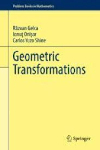- About MAA
- Membership
- MAA Publications
- Periodicals
- Blogs
- MAA Book Series
- MAA Press (an imprint of the AMS)
- MAA Notes
- MAA Reviews
- Mathematical Communication
- Information for Libraries
- Author Resources
- Advertise with MAA
- Meetings
- Competitions
- Programs
- Communities
- MAA Sections
- SIGMAA
- MAA Connect
- Students
- MAA Awards
- Awards Booklets
- Writing Awards
- Teaching Awards
- Service Awards
- Research Awards
- Lecture Awards
- Putnam Competition Individual and Team Winners
- D. E. Shaw Group AMC 8 Awards & Certificates
- Maryam Mirzakhani AMC 10 A Awards & Certificates
- Two Sigma AMC 10 B Awards & Certificates
- Jane Street AMC 12 A Awards & Certificates
- Akamai AMC 12 B Awards & Certificates
- High School Teachers
- News
You are here
Geometric Transformations

Publisher:
Springer
Publication Date:
2022
Number of Pages:
591
Format:
Hardcover
Price:
74.99
ISBN:
978-3-030-89116-9
Category:
Problem Book
[Reviewed by , on ]
Mark Hunacek
10/4/2022
Despite Felix Klein’s 1872 Erlangen Programme address, in which he advocated studying and classifying geometries based on their transformations, the infusion of geometric transformations into the American educational system has been a comparatively recent occurrence. Certainly, when I was a high school student studying geometry in the mid-1960s, geometric transformations were not on anybody’s radar. Now, however, they are part of the Common Core syllabus for high school geometry courses. The last few decades have also seen some textbooks discussing these ideas. Dodge’s Euclidean Geometry and Transformations was published in 1972, and about a decade letter Martin wrote Transformation Geometry. Other books on this topic include (but are by no means limited to) Continuous Symmetry: From Euclid to Klein by Barker and Howe, Yaglom’s four-volume set Geometric Transformations, King’s Geometry Transformed, and Umble and Han’s Transformational Plane Geometry. And now there is this book, which is a nice addition to the literature.
This is a problem-oriented text (with many of the problems coming from contests), focusing on Euclidean plane geometry. The book is divided into three parts (Problems, Hints, Solutions), each consisting of four chapters. The first three chapters in each part discuss, respectively, isometries, homotheties (what I learned as dilations), and inversions. The fourth chapter in each part blends these together and focuses on problems that use more than one kind of transformation. The first part of the book contains a number of worked-out problems in the text, and also provides more than 250 problems for the reader to work on, solutions to which are found in the last part.
Although this book is problem-oriented, it does not consist entirely of problems; there is a theoretical development of the material in each chapter as well. The authors use both analytic and synthetic methods as appropriate. They identify the Euclidean plane with the set of complex numbers, thus allowing them to exploit the properties of complex numbers in analyzing transformations. Such an approach allows, for example, a very explicit general form for isometries: they are precisely the mappings of the form \( f(z) = rz + s \), where \( z \), \( r \) and \( s \) are complex numbers and \( r \) has norm 1.
The development of the material is quite interesting. It includes not only a discussion of the basic properties of each kind of transformation, but also an indication of some applications of these transformations. Some of these were new to me, including a transformation-theoretic proof (due to Connes) of Morley’s theorem on angle trisectors in a triangle, and also transformation-theoretic proofs of results in number theory such as Wilson’s theorem. A useful pedagogical approach is the occasional presentation of multiple proofs or solutions, to emphasize different techniques.
It seems unlikely that this book will find much use as an actual classroom text, simply because there aren’t that many courses being taught that are devoted entirely to geometric transformations. But for instructors teaching geometry courses in which these are a topic, this book should provide an excellent source of interesting examples and problems. The large number of solved problems should also make useful reading for people preparing for mathematical contests and Olympiads.
See the publisher's website.
- Log in to post comments




